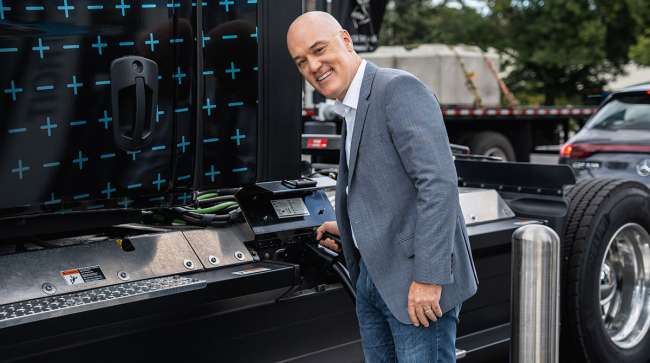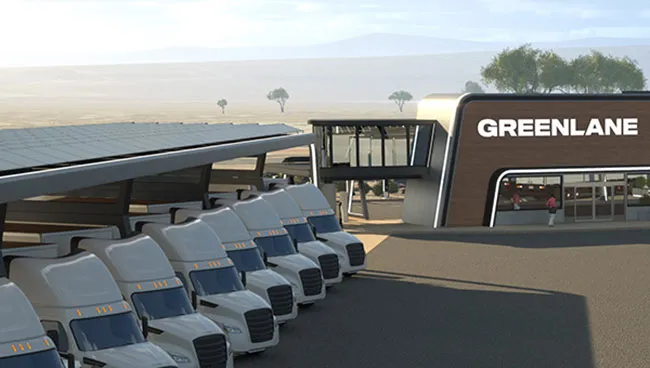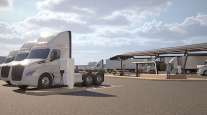Staff Reporter
Greenlane to Break Ground on Charging Network in Early 2024

[Stay on top of transportation news: Get TTNews in your inbox.]
Daimler Truck North America and its partners in the proposed Greenlane electric and hydrogen vehicle fueling network expect to break ground at their first sites in early 2024, a spokeswoman for Freightliner’s owner told Transport Topics on Oct. 3.
Driving the push to build the infrastructure network will be newly appointed Greenlane CEO Patrick Macdonald-King, DTNA and partners NextEra Energy Resources and BlackRock said Sept. 28.
NextEra is a power producer based in Juno Beach, Fla. BlackRock is one of the world’s largest investment firms.
Macdonald-King was previously chief operating officer at EV Connect, a charging network provider with operations across North America, Europe and Australasia. Before that, Macdonald-King founded and was CEO of DAX, a software-as-a-service asset management and cloud workflow application.
Greenlane is set to build a public zero-emission charging and hydrogen-fueling network for medium- and heavy-duty battery-electric and hydrogen fuel cell vehicles. The network of charging sites is scheduled to be built on critical freight routes on the East and West coasts and in Texas, according to the partners.

Rendering of a public charging area by Greenlane. (Daimler Truck North America)
The first corridors for the $650 million venture will be operational within a year of the groundbreaking, the spokeswoman said, adding that the first site will be in Southern California, and additional sites were being acquired along “various freight routes.”
When Greenlane was first announced in April, DTNA CEO John O’Leary said the joint venture “is designed to begin to tackle one of the greatest hurdles to the trucking industry’s decarbonization — infrastructure. The nation’s fleets can only transform with the critical catalyst of publicly accessible charging designed to meet the needs for medium- and heavy-duty vehicles.”
Greenlane is one of a number of high-profile alternative fuel joint ventures in the trucking industry for DTNA and its parent group, Germany’s Daimler Truck AG. In September, Daimler Truck, Accelera by Cummins and Paccar Inc. unveiled plans to build a U.S. plant that will manufacture battery cells for electric commercial vehicles and industrial applications.
Greenlane’s first site will be in California, which has the biggest incentives and most aggressive goals of any state in the U.S. when it comes to Class 8 trucks powered by alternative fuels. Seven of the eight fleets in the North American Council for Freight Efficiency’s latest Run on Less program tested electric vehicles in California through Sept. 30.
However, concerns are growing that the nation-leading state is falling behind in its ability to provide enough charging infrastructure to meet the goals.
Some 157,000 chargers capable of powering medium- and heavy-duty trucks must be installed to meet the targets of the California Air Resources Board’s controversial Advanced Clean Fleets rule. That equates to building around 300 chargers a week, a level not being met, California Trucking Association CEO Eric Sauer told TT on Sept. 6.
Meeting targets set by mandates such as ACF and the Global Memorandum of Understanding on Zero-Emission Medium- and Heavy-Duty Vehicles signed by the Biden administration in 2022 will require a multiphase buildout strategy, nongovernmental organization Calstart said in a road map released in August.
The priorities for the strategy should include priority launch areas with clusters of chargers, government backing, incentives and lower cost energy, Calstart said.
Want more news? Listen to today's daily briefing above or go here for more info
However, electricity companies warn that connection times could be extremely long, especially for larger facilities. Bureaucracy is likely to take time to work through and the power industry currently moves at a glacial pace, even compared with the trucking industry, observers told American Trucking Associations’ Technology & Maintenance Council’s 2023 Summer Conference & Fleet/Utility Forum in June.
In September, a National Grid-backed study concluded investment in high-priority charging areas was needed, with a focus on states with clear electrification targets. The study also concluded that collaboration with fleets and vehicle manufacturers would need to rise too.




